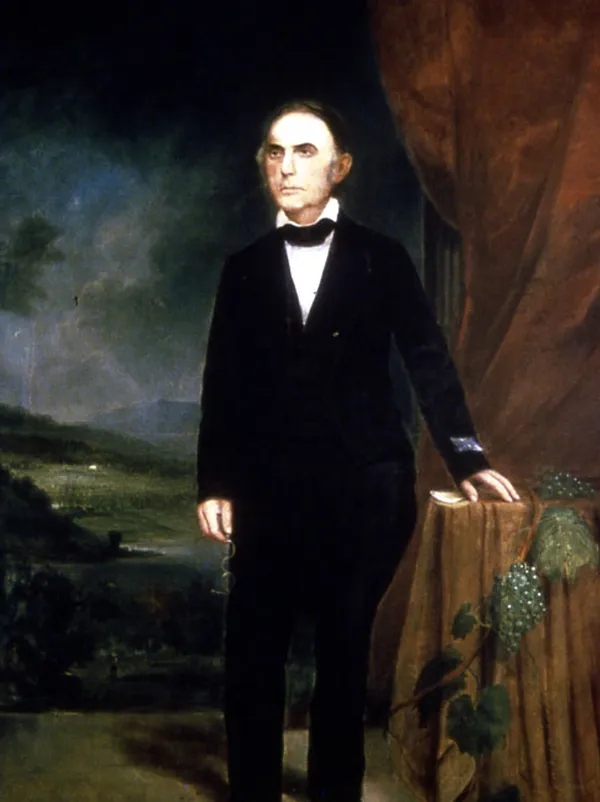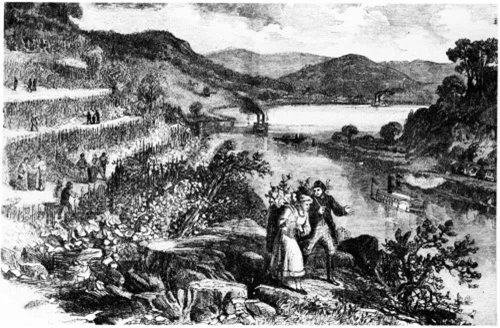I wrote this article as a guest post for “Wine, Wit, and Wisdom”—the official blog of the Society of Wine Educators—which published it on January 3, 2021.
He was an unlikely character working with an unlikely grape in an unlikely location that would nevertheless become the cradle of American winemaking: The state of Ohio.
Yes, Ohio.
Born in 1783 in New Jersey, Nicholas Longworth arrived in Cincinnati, Ohio, by flatboat at age 20, when that city was only a frontier hamlet of about 750 people on the banks of the Ohio River. Longworth’s father was a Revolutionary War era loyalist to the Crown of England and lost most of his land and wealth to confiscation after the war, so Nicholas spent his boyhood in poverty. For a while, he was apprenticed to a shoemaker, and later his parents sent him to clerk for an older brother in South Carolina before he headed to Ohio on his own.

After studying law under a respected local judge, Longworth opened his own practice and thrived in the booming community. He quickly acquired large real estate holdings, in part by taking land as payment in lieu of legal fees. In the 1820s, he stopped practicing law to manage his real estate empire and pursue his two primary avocations: horticulture and art. He had already become fabulously, sustainably wealthy. In 1850, Longworth paid the second-highest tax bill in the United States; by one estimate, at the peak of his fortune and adjusting for inflation, Longworth’s net worth places him among the 40 wealthiest Americans of all time.[1] Good thing; he had expensive hobbies.
His properties just northeast of Cincinnati’s heart overlooked the Ohio River and included what was later named Mt. Adams, a south-facing and steep ridge that had been stripped of its forest by early settlers for lumber to build their homes and shops. In 1813, he began planting vineyards on that slope, concentrating first on the now extinct Alexander grape. Alexander was considered an accidental hybrid of a native Labrusca species with a European Vinifera vine that was probably planted by colonial Pennsylvania Governor William Penn near Philadelphia, in one of many failed early attempts to grow Vinifera in the colonies. Theoretically, the Labrusca genes allowed the Alexander to survive and the Vinifera genes improved its taste.
Some improvement. Longworth found the only way he could make drinkable wine of Alexander was to add sugar and fortify it with brandy so that what he called “a tolerable imitation of Madeira” was about 20 percent alcohol by volume (40 proof). Cincinnati was (and still is) in the heart of American whiskey territory, and Longworth—a believer in “moderate temperance”—was dismayed at the region’s jug liquor habits. He hoped to produce a wine satisfying and attractive enough to replace whiskey, aiming for a drinkable, dry table wine of 12 percent alcohol or less. His high-test Madeira knockoff wouldn’t do, so he kept looking for a more suitable grape.
In 1825, Longworth bought some vines of the Catawba grape, eventually finding that it did well in the Ohio Valley and that it made a better wine, though still with the notorious foxy traits of v. Labrusca. Thinking that the skins might be the source of Catawba’s musty taste and aroma, Longworth began separating the juice from the skins before fermentation, which produced a dryer and lower-alcohol blush wine. It was less expensive than imported wines and similar enough to Rhine Valley wines that the new Catawba wine proved popular with the waves of German immigrants arriving in the Ohio River Valley, who also became willing workers for Longworth’s expanding vineyards.
However, to the region’s Anglo-Saxon population, that first Catawba wine resembled a sour cider, so they didn’t buy it. Determined to create a commercial success, Longworth continued experiments with other production processes and grapes. Shades of Dom Perignon centuries earlier, Longworth’s wine fortunes changed with an accidental innovation in 1842. A batch of the Catawba wine was mistakenly put through a second fermentation, resulting in a sparkling wine more pleasing and, to Longworth’s intuition, more promising than his still wine.
Problem: He didn’t know how to make good sparkling wines—at least, not on purpose.
Solution: He went to France and brought back winemakers from Champagne to teach him and his employees how. He built a cellar especially for the purpose, and his French winemakers introduced the Methode Champenoise. It was a noisy and sticky education, as bottles kept exploding from the pressure of the second fermentation—42,000 of them in one year alone. Undeterred, Longworth bought more bottles, hired more winemakers—see “fabulously wealthy” above— and began selling the sparkling Catawba as soon as his first unexploded batches came of age.
Longworth’s German clientele liked it— a lot—and, finally, so did the non-Germans around Cincinnati. He began shipping it out of Ohio, and soon East Coast aristocrats who previously sipped only European wines were demanding Longworth’s. By the mid-1850s, Longworth was advertising his sparkling Catawba nationally, producing 100,000 bottles a year, and making a tidy profit from it. The Longworth winery is generally credited with being the first successful commercial winery in the United States, and his sparkling Catawba was unarguably the first commercially viable sparkling wine made in the United States.
One account tells us, “Robert Browning drank it. In the ‘Illustrated London News,’ Charles Mackay said that it ‘transcends the Champagne of France.’”[2] Longworth sent a case of it to the poet Henry Wadsworth Longfellow, who found it inspiring enough to write a poem in tribute – “Catawba Wine.”

(Image from a pamphlet advertising Longworth’s wines, 1866)
Longworth’s success launched an industry in the Cincinnati region; by 1859 there were 2,000 acres of vineyards producing more than 600,000 gallons of wine annually. Most of that was Catawba still wine, as sparkling wine production required deeper pockets than most vintners had.
The boom, however, was short-lived. Nicholas Longworth died in 1863 at age 80, depriving the young industry of its deepest pockets and his well of energy and dedication. Around that same time, black rot and powdery mildew flourished in the region’s humid summers and decimated Ohio’s vineyards. Catawba vines turned out to be increasingly susceptible to the rot as they aged, and by then many were in maturity or beyond. Such problems were not well understood at the time, and there was no simple or affordable cure. With his immense wealth, Longworth could have absorbed his losses had he lived longer, but other vintners in the region could not. Simultaneously, the American Civil War created a shortage of manpower for the vineyards and offered other ways for entrepreneurs to make a living. By 1870, Longworth’s heirs closed his bottling plant, and what remained of Ohio’s wine industry was shifting north to the shores of Lake Erie.
Over his lifetime, Longworth helped Cincinnati grow into a city of more than 160,000, and his presence remains visible in the area today. He is as well known for his patronage of regional artists as for his winemaking, and his mansion— a wood-framed architectural treasure he bought in 1830 and named Belmont—still stands in downtown Cincinnati, housing the Taft Museum of Art. The slopes of Mt. Adams where he planted his first vineyards now feature urban neighborhoods, parks, and expressways, but Cincinnati remains at the center of today’s Ohio River Valley American Viticultural Area (AVA), the largest in square mileage of Ohio’s five AVAs.
Longworth’s family legacy still touches American art and politics. One of his granddaughters, the pottery artist Maria Longworth Nichols Storer, co-founded Rookwood Pottery in Cincinnati, which is still in business and a familiar name to antique lovers (hello, Antiques Roadshow!). One of his great-grandsons, Nicholas Longworth III, became an attorney and Ohio politician of note who served in the U.S. House of Representatives for almost 30 years in the early 20th century, including six years as Speaker. He married President Theodore Roosevelt’s famously sharp-witted daughter Alice in a 1906 White House ceremony, and the Longworth House Office Building in Washington, DC, is named for him.
To learn more:
- Nicholas Longworth – Catawba Wine Bitters
- Grape-Growing and Winemaking in Cincinnati, 1800 – 1870
- Nicholas Longworth and the Cincinnati Region
- Nicholas Longworth: Art Patron of Cincinnati
[1] https://www.philanthropyroundtable.org/almanac/people/hall-of-fame/detail/nicholas-longworth
[2] http://www.weekendwinery.com/wineryinsight/Article_Jul03.htm
Pingback: My Relationship With Wine | The Libation Lounge